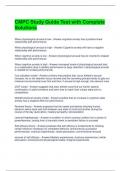CMPC Study Guide Test with Complete
Solutions
When physiological arousal is low - Answer-cognitive anxiety has a positive linear
relationship with performance
When physiological arousal is high - Answer-Cognitive anxiety will have a negative
relationship with performance
When cognitive anxiety is low - Answer-physiological arousal has an inverted U-shaped
relationship with performance
When cognitive anxiety is high - Answer-increased levels of physiological arousal lead
to a catastrophic drop in athletic performance (a large reduction in physiological arousal
is needed to increase performance)
Cue utilization model - Answer-a theory that predicts that, as an athlete's arousal
increase, his or her attention focus narrows and the narrowing process tends to gate out
irrelevant environmental cues first and then, if arousal is high enough, the relevant ones
IZOF model - Answer-suggests that each athlete could find out his/her optimal
combination of useful emotions and learn how to reach their unique state prior to
competitions
Multidimensional anxiety model - Answer-predicts that an increase in cognitive state
anxiety has a negative effect on performance
Reversal theory - Answer-proposes that the needs and desires directing human
behavior switch back and forth between one state of mind and another during the
course of the day (autic/alloic, mastery/sympathy, telic/paratelic)
Learned helplessness - Answer-a condition in which a person suffers from a sense of
powerlessness, arising from a traumatic event or persistent failure to succeed
Self-efficacy theory - Answer-proposes that self-efficacy is fundamental to initiating
certain behavior necessary for competent behavior (enhanced by successful
performances, vicarious experiences, verbal persuasion, and emotional arousal)
sources of self-efficacy - Answer-Mastery experiences; vicarious experiences; verbal
persuasion; emotional and physiological states; imaginal experiences
,Social cognitive theory - Answer-an approach to social learning, incorporating findings
from research into learning, memory, and social cognition, and focusing on people's
thoughts and how they affect social behavior
Lewin's behavioral leadership styles (participative leadership) - Answer-autocratic
(make decisions without consulting their teams), democratic (allow the team to provide
input), & laissez-faire (don't interfere)
Fiedler's contingency model (situational leadership) - Answer-task-oriented leaders
usually view their LPCs more negatively (good at completing tasks and organizing a
group) & relationship-oriented leaders usually view their LPCs more positively (good at
managing conflict and making complex decisions)
Hersey and Blanchard's situational leadership - Answer-telling, selling, participating, and
delegating
House and Mitchell's path-goal theory (situational leadership) - Answer-directive,
supportive, participative, and achievement
French and Raven's power model - Answer-legitimate, reward, expert, referent,
coercive, and informational
Transactional leadership - Answer-assumes people do things for reward and for no
other reason (focused on designing tasks and reward structures)
Transformational leadership - Answer-leaders show integrity and know how to develop
a robust and inspiring vision of the future
Servant leadership - Answer-focuses primarily on the growth and well-being of people
and the communities to which they belong by sharing power, putting the needs of others
first, and helping people develop and perform as highly as possible
motor learning stages - Answer-cognitive, associative, autonomous
Cognitive state (motor learning) - Answer-initial stage; the goal is to develop an overall
understanding of the skill (learner mostly relies on visual input and trial & error to guide
learning)
Associative stage (motor learning) - Answer-learner begins to demonstrate a more
refined movement through practice (proprioceptive cues become more important)
Autonomous stage (motor learning) - Answer-final stage; the motor skill becomes
mostly automatic requiring little cognitive involvement
behaviorism - Answer-associations between stimuli and responses
, cognitive-information processing - Answer-Gestalt theory, feedback
social learning/constructivism - Answer-construct knowledge of world based on
individual experience
observational learning (Bandura) - Answer-attention, retention, motor production, and
motivation
phases of mental skills development - Answer-education phase (awareness focus),
acquisition phase (learning focus), and implementation phase (over-learning and
execution focus)
The Female Triad - Answer-relationships between energy availability (low vs. high; e.g.,
eating disorders), menstrual function (functional hypothalamic amenorrhea vs.
eumenorrhea), and bone mineral density (optimal bone health vs. osteoporosis)
energy availability - Answer-Dietary intake minus exercise energy expenditure
1st energy goal to manage - Answer-increase energy availability by increasing energy
intake and/or reducing exercise energy expenditure (nutritional counseling/monitoring)
Self-determination theory - Answer-autonomy, relatedness, competence
negotiating reality defined (Friedman) - Answer-- active awareness of oneself as a
complex being and the effect of one's culture on thinking and action
- an ability to engage with others to explore tacit assumptions that underlie behavior and
goals
- an openness to testing out different ways of thinking and doing things
Bennet (1998) six-stage model of working with cultural differences - Answer-1. denial of
difference (isolation)
2. defense (perceiving cultural difference as a threat to their worldview)
3. minimization (accepting superficial differences while maintaining the assumption that
people are basically the same)
4. acceptance (recognizing the viability of different cultural norms
5. adaptation (knowing enough about another culture to intentionally shift frame of
reference and modify behavior to fit its norms)
6. integration (reconciling cultural differences and forging a multicultural identity)
Negotiating reality underlying beliefs - Answer-- all people are of equal importance and
worthy of equal respect
- as cultural beings, people differ because they possess different repertoires of ways of
seeing and doing things
- the repertoire of no individual or group merits a priori superiority or right to dominance
advocacy - Answer-clearly expressing and standing up for what one thinks and desires




